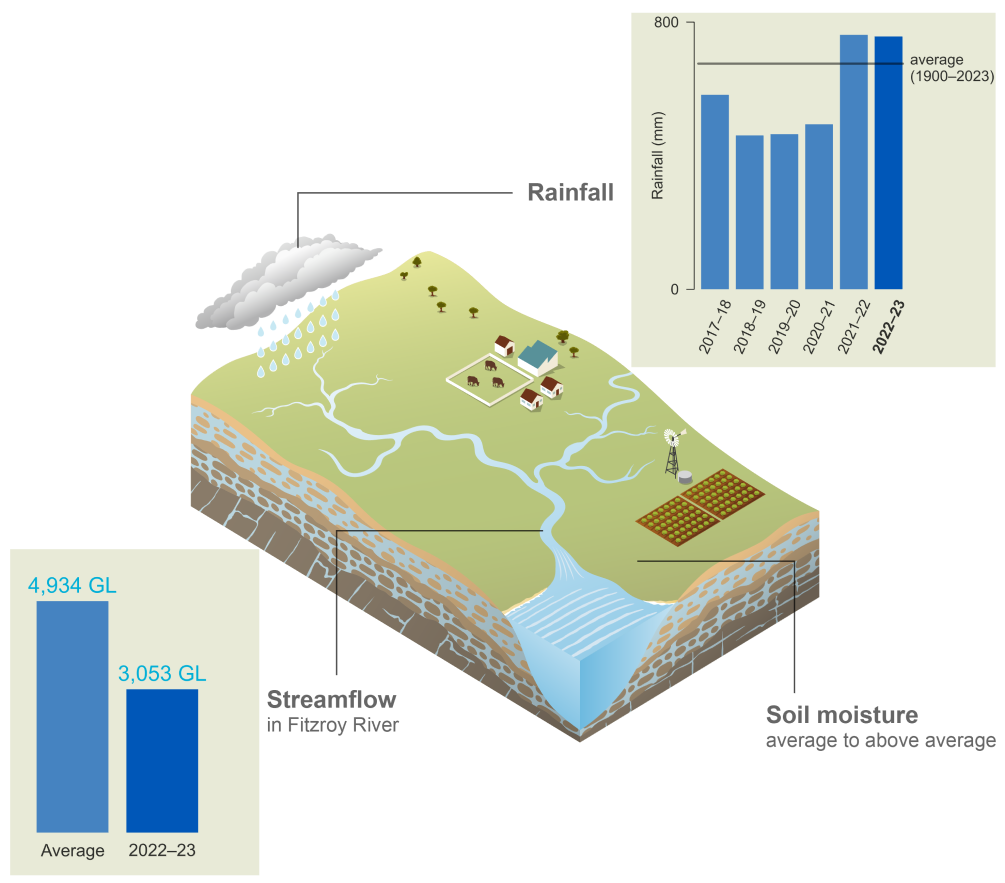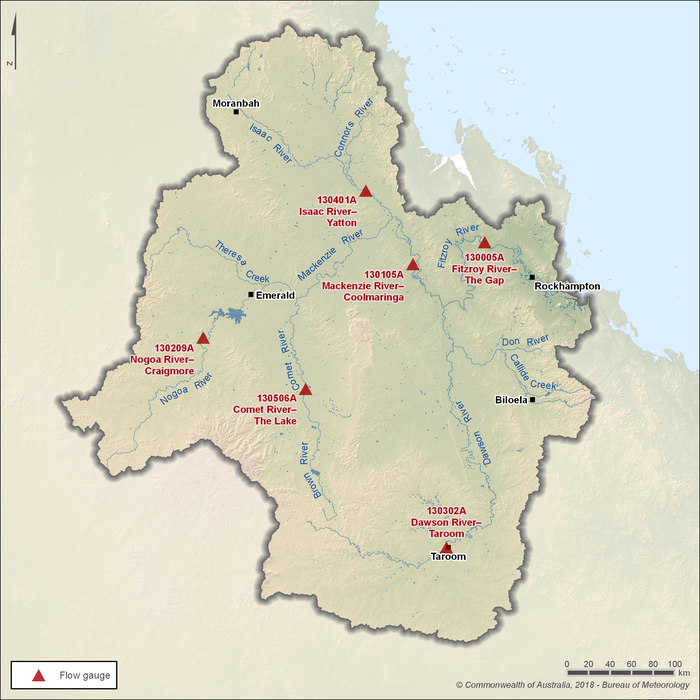Fitzroy: Climate and water
For the water account period 01 July 2022 - 30 June 2023
- Total annual rainfall for the 2022-23 year was above average for the second consecutive year, with the region recording its eighth wettest spring on record.
- Soil moisture in the root zone (0-1 m depth) was average to above average for most of the region, reflecting the region's above average rainfall.
- Total annual flows in the region's major rivers were below average at all sites.

For further information on the region's climate and water conditions during the 2022-23 year scroll down this page or click on the links below:
About the region
- The Fitzroy region is dissected by the Tropic of Capricorn, resulting in the region lying within two climatic zones, with the northern and eastern areas characterised by a subtropical climate, while the southern and western areas are characterised by a semi-arid inland subtropical climate. Summers are generally hot with variable humidity, while winters are mild and dry.
- Rainfall in the region has a high inter-annual variability, where some years are extremely wet, followed by years of drought. Higher rainfall totals are more common during the northern wet season (October to April), but are not unusual to occur any time of the year. Coastal areas generally have a much wetter climate.
- Streamflows in the region's rivers typically reflect the distribution of rainfall. Most of the streamflows and storage inflows occur during the northern wet season (October to April), while streamflows can cease to flow during the northern dry season (May to September).
Climate conditions
Rainfall
Figure C1 Annual and monthly rainfall deciles for the Fitzroy region during the 2022-23 year
- Total area-averaged rainfall for the 2022-23 year was 757 mm, 12% above the mean value of 676 mm. This was the region's second consecutive year of above average rainfall.
- An unseasonable rainband brought more than three times the monthly average during July 2022.
- In September 2022, a third consecutive La Niña event was declared in the tropical Pacific Ocean (Climate Driver Update) and remained active through to March 2023. La Niña events tend to increase the chances of above average rainfall during the northern wet season.
- With the influence of La Niña, spring rainfall for the region was the eighth highest on record.
- Inland low-pressure troughs brought extensive rainfall to the region during October 2022, with some areas in the north, including part of the catchment area for Lake Maraboon (Fairbairn Dam), receiving highest October totals on record.
- Most notable in the southern half of the region, rainfall was below average throughout summer and autumn, particularly during February 2023 which is typically the wettest part of the year. Only January and March 2023 recorded above average rainfall.
- Rainfall during the 2022-23 wet season was slightly above average and accounted for 75% of the total area-averaged rainfall for 2022-23. No cyclones affected the region during 2022-23. Further information on the 2022-23 wet season can be found at: Australia's 2022-23 Northern Wet Season.
- Little rainfall was recorded in May 2023 and June 2023, with the region receiving 16% of the May to June monthly averages combined.
- More information on Australia's climate and water over the 2022-23 year can be found at: Financial year climate and water statement 2022-23.
Figure C2 Total monthly rainfall for the Fitzroy region during the 2022-23 year compared with the average and percentiles for the region
- An unseasonable rainband resulted in rainfall during July 2022 peaking above the 90th percentile.
- Rainfall during September 2022 and October 2022 was equal to or above the 90th percentile.
- February 2023 rainfall was less than half the monthly average, but remained above the 10th percentile.
- There was little rainfall during the last two months of the 2022-23 year, however June 2023 was the only month to record rainfall below the 10th percentile.
Actual evapotranspiration
Figure C3 Annual and monthly actual evapotranspiration deciles for the Fitzroy region during the 2022-23 year
- Total area-averaged actual evapotranspiration for the 2022-23 year was predominantly above average, with above average July to November rainfall increasing water availability across the region.
- A wet July and spring helped maintain above average evapotranspiration in most areas through to December 2022.
- Below average rainfall throughout summer over the southern half of the region resulted in below average evapotranspiration.
- By the end of the 2022-23 wet season, evapotranspiration was mostly average to above average with near average rainfall during March 2023 and April 2023.
- Little rainfall during May 2023 and June 2023 significantly reduced water availability across the region, resulting in much of the region experiencing below average evapotranspiration during the last two months of the 2022-23 year.
Soil moisture
Figure C5 Annual and monthly soil moisture deciles for the Fitzroy region during the 2022-23 year
- Soil moisture in the root zone (0–1m depth) for the 2022-23 year was average to above average for most of the region, following the second consecutive year of above-average rainfall.
- Unseasonable rainfall during the 2022 dry season resulted in predominantly above average soil moisture through to the start of the 2022-23 wet season.
- Following the onset of the 2022-23 wet season, well above average spring rainfall maintained higher than average soil moisture into early summer.
- Below average rainfall throughout summer, particularly during February 2023, resulted in a decrease in soil moisture, with much of the southern half of the region experiencing average to below average soil moisture during January 2023 and February 2023.
- With near average March 2023 and April 2023 rainfall, soil moisture returned to average over all but the most southern areas.
- Little rainfall during May 2023 and June 2023 resulted in much of the region experiencing below average soil moisture during the first two month of the 2023 dry season.
- More information on soil moisture distribution across the Fitzroy region is available in the Australian Water Outlook.
Streamflow responses

Figure
C6 Key flow gauging stations along the main rivers within the Fitzroy region
- The six main rivers in the region are the Fitzroy, Dawson, Nogoa, Mackenzie, Isaac, and Comet rivers, which correspond to the six sub-basins used for environmental water management (see the Water management section in 'Region description' for more information).
Figure C7 Total monthly flow for major rivers in the Fitzroy region during the 2022-23 year compared with the average and percentiles
- Despite average to above average annual rainfall over all but the most southern part of the region, total annual flows in the major rivers were below average at all sites.
- The Fitzroy River at The Gap (Station 130005A), the region's largest river, recorded a total annual flow volume of 3,053 GL compared to the average annual flow volume of 4,934 GL. Streamflow in the Mackenzie River at Coolmaringa (Station 130105B), the second largest river, was 40% below the average annual flow volume.
- Unseasonable rainfall during July 2022 resulted in streamflows in the Mackenzie River at Coolmaringa, the Dawson River at Taroom (Station 130302A) and the Isaac River at Yatton (Station 130401A) peaking well above the 90th percentile. This reflected the distribution of rainfall across the region during this rain event.
- Above-average rainfall during September 2022 resulted in the Dawson River at Taroom recording its third-highest streamflow on record for September. All other streamflow sites remained near or below average for September 2022.
- With heavy rainfall during October 2022, streamflows were above the 90th percentile at all sites, and, with the exception of Mackenzie River at Coolmaringa and the Isaac River at Yatton, remained above average during November 2022.
- While there were some higher streamflows in the northern half of the region during January, drier conditions for the rest of the wet season saw well below average streamflows until the end of 2022-23.









